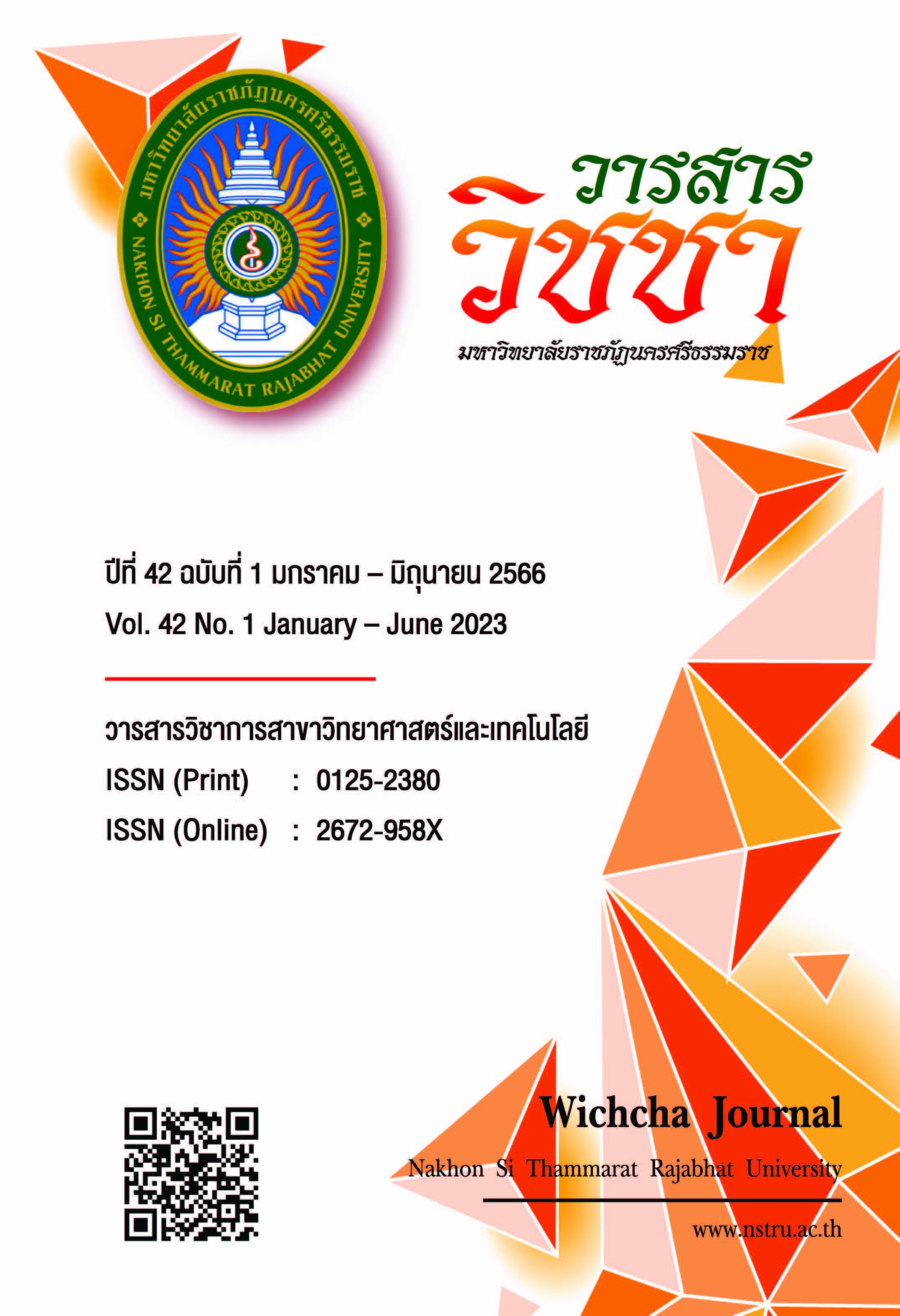The Development of Nipa Palm Sugar Stirrer Machine with Automatic Control
Main Article Content
Abstract
The objectives of this research were 1) to innovate and develop the automatic nipa palm sugar mixer, 2) to explore the efficiency of the automatic nipa palm sugar mixer, and 3) to analyze the engineering economy of the automatic nipa palm sugar mixer. The instruments employed in the research consisted of the automatic nipa palm sugar mixer and the automatic nipa palm sugar mixer, and an efficiency evaluation form. Mean and Standard Deviation were used in data analysis. The results of the study reveal that 1) the mixer is made of the steel with the shaft and blades made of food industrial stainless steel; using 220 voltage - 50 hertz power; controlled by the wireless Android application - Arduino Board. 2) In 5 times of nipa palm sugar mixing for the amount of 10, 15, 20, 25, and 30 kilograms, the human workforce took averagely 25.0, 31.2, 40.2, 59.4, and 70.4 minutes, respectively to finish the mixing process. However, in the same conditions, the automatic sugar mixer took averagely 11.4, 17.8, 19.8, 29.8 and 35.2 minutes respectively to finish mixing the sugar. And 3) The results of engineering economy analysis of the automatic nipa palm sugar mixer, comparing between the human workforce and the automatic mixer excluding mixer developing cost, indicated that the mixing the nipa palm sugar by the automatic mixer costs 4,196.70 baht per year; and mixing the nipa palm sugar by human workforce costs 90,000 baht per year. It is concluded that the automatic mixer reduces the nipa palm sugar manufacturing cost for 85,803.30 baht per year or 95.33%.
Article Details

This work is licensed under a Creative Commons Attribution-NonCommercial-NoDerivatives 4.0 International License.
เนื้อหาและข้อมูลในบทความที่ลงตีพิมพ์ในวารสารวิชชา มหาวิทยาลัยราชภัฏนครศรีธรรมราช ถือเป็นข้อคิดเห็นและความรับผิดชอบของผู้เขียนบทความโดยตรง ซึ่งกองบรรณาธิการวารสารไม่จำเป็นต้องเห็นด้วยหรือร่วมรับผิดชอบใด ๆ
บทความ ข้อมูล เนื้อหา รูปภาพ ฯลฯ ที่ได้รับการตีพิมพ์ในวารสารวิชชา มหาวิทยาลัยราชภัฏนครศรีธรรมราช ถือเป็นลิขสิทธ์ของวารสารวิชชา มหาวิทยาลัยราชภัฏนครศรีธรรมราช หากบุคคลหรือหน่วยงานใดต้องการนำข้อมูลทั้งหมดหรือส่วนหนึ่งส่วนใดไปเผยแพร่ต่อหรือเพื่อการกระทำการใด ๆ จะต้องได้รับอนุญาตเป็นลายลักษณ์อักษรจากวารสารวิชชา มหาวิทยาลัยราชภัฏนครศรีธรรมราชก่อนเท่านั้น
The content and information in the article published in Wichcha journal Nakhon Si Thammarat Rajabhat University, It is the opinion and responsibility of the author of the article. The editorial journals do not need to agree. Or share any responsibility.
References
กรมทรัพยากรทางทะเลและชายฝั่ง. (2557). รายงานประจำปี 2557 กรมทรัพยากรทางทะเลและชายฝั่ง. กรุงเทพฯ: กรมทรัพยากรทางทะเลและชายฝั่ง.
กฤษณะ จันทสิทธิ์ คมสัน มุ่ยสี และศรายุทธ์ จิตรพัฒนากุล. (2560). การพัฒนาเครื่องกวนเนื้อมังคุดชนิดควบคุมอุณหภูมิกึ่งอัตโนมัติ สำหรับวิสาหกิจชุมชนบ้านท่าศาลา อำเภอท่าใหม่ จังหวัดจันทบุรี. รายงานวิจัย. มหาวิทยาลัยราชภัฏรำไพพรรณี.
กอบเกียรติ สระอุบล. (2561). พัฒนา IoT บนแพลตฟอร์ม Arduino และ Respber Pi. กรุงเทพฯ: อินเตอร์มีเดีย.
ชินวัจน์ งานวรรณาการ สุทัศน์ รุ่งระวิวรรณ และอมรเทพ มณีเนียม. (2561). การพัฒนาระบบควบคุมอุปกรณ์ภายในโรงงานขนาดย่อมด้วยเทคโนโลยีไร้สายผ่านแอปพลิเคชันบนอุปกรณ์เคลื่อนที่ภายใต้แนวคิดอินเทอร์เน็ตสำหรับทุกสรรพสิ่ง. รายงานวิจัย. มหาวิทยาลัยราชภัฏยะลา.
นพรัตน์ บำรุงรักษ์. (2540). การศึกษาด้านนิเวศวิทยา ประโยชน์ใช้สอย และการขยายพันธุ์ต้นจากในพื้นที่ลุ่มน้ำปากพนัง จ.นครศรีธรรมราช. รายงานวิจัย. มหาวิทยาลัยสงขลานครินทร์.
ภูมิพัฒน์ ก๋าคำ ฐาปนา นามประดิษฐ์ ลัคนา เพิ่มพูน และบุญส่ง พลสัมฤทธิ์. (2564). การพัฒนาเครื่องบันทึกข้อมูลราคาประหยัดสำหรับการเกษตรสมัยใหม่. วารสารวิชชา มหาวิทยาลัยราชภัฏนครศรีธรรมราช, 40(2), 1-13.
รัฐพล ดุลยะลา. (2559). การพัฒนาเครื่องกวนทุเรียนแบบผสมผสาน เพื่อมาตรฐานผลิตภัณฑ์ทุเรียนกวน กลุ่มวิสาหกิจแปรรูปผลไม้ลับแล. รายงานวิจัย. มหาวิทยาลัยราชภัฏอุตรดิตถ์.
ศิริพร หมื่นหัสถ์ พัชรินทร์ โสมปาน เบญจา ทองพันธ์ และตรีฤกษ์ เพชรมนต์. (2561). รูปแบบการบริหารจัดการและช่องทางการจัดจำหน่ายเพื่อเพิ่มมูลค่าผลิตภัณฑ์อาหารจากต้นจากสำหรับกลุ่มวิสาหกิจชุมชนพื้นที่อำเภอปากพนัง. รายงานวิจัย. มหาวิทยาลัยราชภัฏนครศรีธรรมราช.
สุนันทา ข้องสาย. (2563). สภาวะที่เหมาะสมในการเตรียมและความสามารถในการดูดซับของถ่านกัมมันต์ที่ผลิตจากวัสดุเหลือใช้ในการผลิตใบจากมวนยาสูบ. วารสารวิชชา มหาวิทยาลัยราชภัฏนครศรีธรรมราช, 39(1), 46-57.
Ferguson, G.A. (1981). Statistical analysis in psychology and education. (5th ed). Tokyo: McGraw-Hill.


